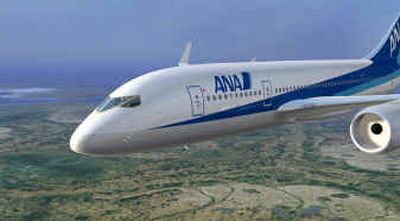7E7 Dreamliner to put passengers in lap of luxury

SEATTLE — The first new American commercial jetliner to be built in more than a decade won’t be the biggest or fastest passenger plane in the sky.
Nor will Boeing’s 7E7 Dreamliner stun onlookers with a radically different appearance. Rival Airbus sneers at the “little airplane” as nothing special, and the basic design is another “cigar with wings” — the shape that has defined jets for decades.
But the mid-sized 7E7, being tweaked and simulated in Boeing design labs and three-dimensional computer design images, should offer plenty to wow airlines and the first paying passengers in 2008.
Boeing says the new plane will fly faster, higher, farther, cleaner, quieter and more efficiently than any other medium-sized jet, using 20 percent less fuel. There’ll also be bigger windows, seats, lavatories and overhead bins, which the company shows off to prospective buyers and other visitors at a mock-up of the airplane’s interior not far from its sprawling Seattle-area manufacturing complexes.
Analysts say further 7E7 orders, which Boeing promises will be announced soon, could signal not only a successful new plane but a renaissance for the company.
“For the first time in a while, Boeing has seized the industry initiative,” said aerospace analyst Richard Aboulafia of the Teal Group. “When it comes to making a plane that’s more economical — it’s just a matter of time before everybody falls in line.”
It’s still a gamble. By adopting a sharply opposed strategy to that of Airbus, which thinks its superjumbo A380 will be the jet of choice following its 2006 debut, Boeing risks misgauging years’ worth of demand. That’s what happened with two projects it dropped in the past three years — the 747X, an enlarged jumbo jet, and the super-fast Sonic Cruiser, which was seen as pricey even before the economic fallout from Sept. 11, 2001.
“That was a case where we misjudged the market a little bit,” David von Trotha, Boeing’s chief engineer for product development, said this month. “What we thought would be attractive … turned out to be different from what the market wanted.”
All signs are that the 7E7 — the “E” stands for efficient — is headed for a better fate.
Alan Mulally, chief executive of Boeing Commercial Airplanes, speaks of the plane with an evangelical fervor. He told reporters Boeing was in talks for deals involving more than 400 7E7s beyond the initial, record 50-plane order from All Nippon Airways last month, including more than a dozen firm offers.
“We’re getting great interest from around the world,” Mulally said. “The interest in this plane is going to be absolutely a game-changer” in the industry.
Here are some of the noteworthy features planned for Boeing’s 11th passenger jet series:
• Fuel savings. The 7E7 will be no slouch for speed, cruising at 560 mph — comparable to the largest jets. But the big appeal to cash-pinched airlines is Boeing’s promise that it will allow them to cut fuel costs and fly long, point-to-point routes between cities that can’t fill a bigger plane.
Like flying SUVs, airplanes consume an extraordinary amount of jet fuel — it takes 47,000 gallons to gas up a Boeing 747. But Boeing says the 7E7 will burn 20 percent less fuel than similar-sized planes.
New engines being developed for the 7E7 will be 10 percent more efficient and a supercomputer can design the plane with minimal drag, making it more streamlined.
• Cabin comfort. For most people, walking onto an airplane isn’t exactly pleasant: You’re immediately confronted by a dark metallic galley, narrow aisles and a jumble of passengers trying to cram their bags into overhead compartments and their bodies into tiny, well-worn seats.
With airlines struggling to eke out a profit, Boeing can’t promise luxury accommodations on the 7E7. But it is trying to create a more welcoming environment with a completely redesigned interior.
The design calls for slightly wider seats and bigger restrooms and overhead bins.
• Better air quality. There’s another reason to dread getting on an airplane: the dry, recycled air that can make your eyes sting, dry out your sinuses and add to flying fatigue.
With the 7E7, passengers will feel like they are at a maximum altitude of 6,000 feet, rather than the normal 8,000 feet. Boeing also is considering adding humidifiers to further reduce dryness. That’s feasible because the 7E7 will rely more heavily on composite materials — instead of aluminum — meaning there is less risk of corrosion from the added moisture.